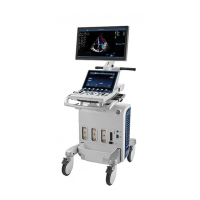Image Optimization
5-6 Vivid S70 / S60 – User Manual
BC092760-1EN
01
• Use the Depth control to adjust the range to be imaged.
• Use the Frequency control (move to higher frequencies) or
the Frame rate control (move to lower frame rate) to
increase resolution in image.
• Use the Frequency control (move to lower frequency) to
increase penetration.
• Use the Reject control to reduce noise in the image.
• Use the DDP control to optimize imaging in the blood flow
regions and make a cleaner, less noisy image.
• Use UD Clarity (Cardiac) or UD Speckle reduce
(non-cardiac) to reduce image speckle. Extra care must be
taken to select the optimal Speckle reduction level, as too
much filtering of speckle can mask or obscure desired
image detail.
• Adjust Octave to toggle between Fundamental and
Harmonic mode.
• Press Color maps and select a gray map from the menu on
screen.
• Use HD (High Definition) to smooth out the speckle and
reduce the noise in the image.
• Use ACE (Adaptive Contrast Enhancement) to emphasize
echoes from real structures while reducing noise/haze. This
will result in enhanced signal-to-noise ratio. A sub-selection
of ACE allows the user to adjust how much ACE is applied,
including a setting showing the coherence factor.
• If using a 4D probe:
• Adjust the Quick Rotate control on the Touch panel or
press Angle on the Control panel to rotate the scan
plane to pre-defined angles.
• Adjust the Rotate rotary of the Touch panel to fine tune
the angle adjustment.
A scan plane indicator is displayed showing the angle
position of the scan plane.
Always use the minimum power required to obtain acceptable
images in accordance with applicable guidelines and policies.

